Our Story
Please note that the following text was written in 1980 unless indicated otherwise.
The church building in the past
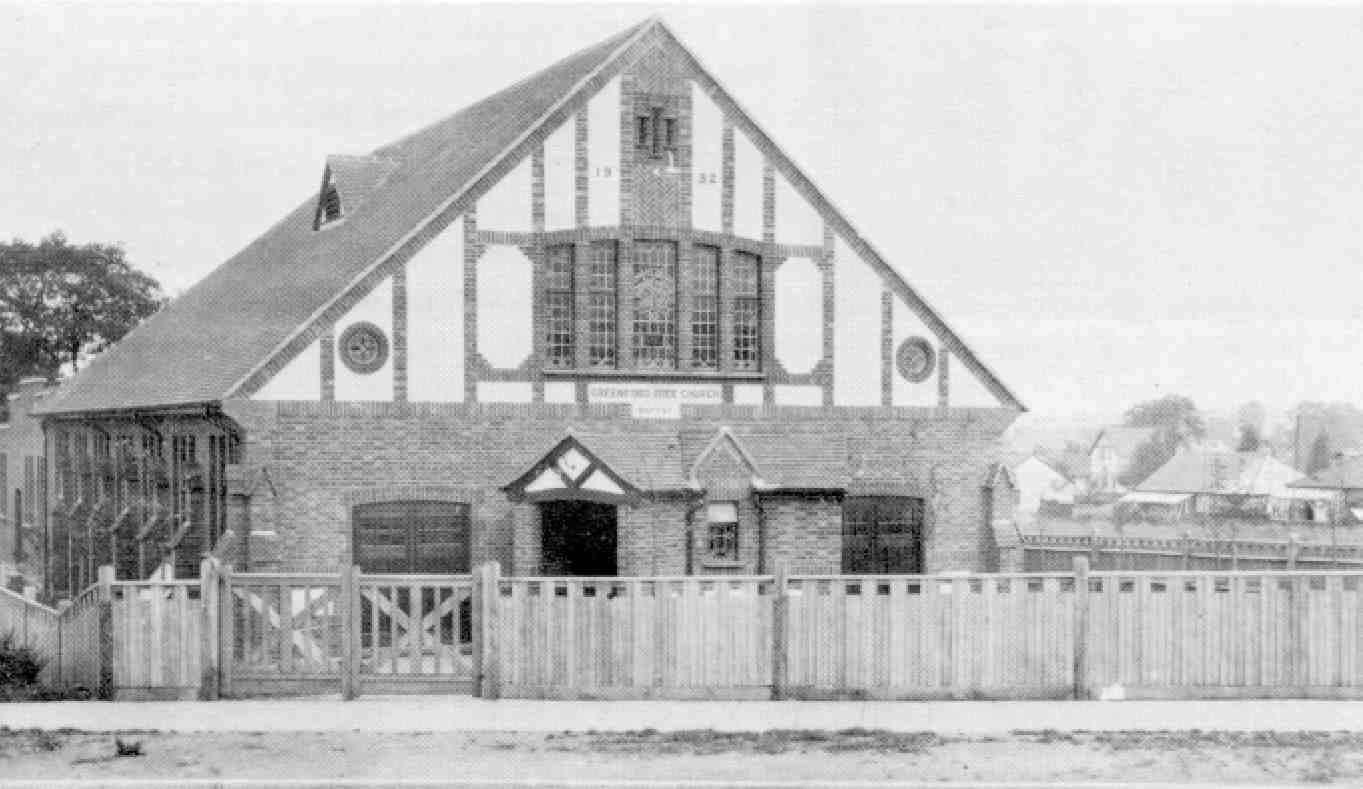 The Previous Church Building in Beechwood Avenue
The Previous Church Building in Beechwood Avenue
Jubilee Greetings from Haven Green Baptist Church, Ealing
"Members and friends of Haven Green send Christian greetings to the fellowship at Greenford Baptist Church on the occasion of your Jubilee. Despite early setbacks through fire and war damage, you have grown as a fellowship and our prayer is that you will continue "to bear fruit in active goodness of every kind, and grow in the knowledge of God." (Colossians Chapter 1 verse 10).
A hundred years ago Haven Green was being built, and we look back with thankfulness to God that from our root, you and other fellowships have grown"
Rev Roger Hayden
Jubilee Greetings from Greenford Methodist Church
"The Minister and people of Greenford Methodist Church send their hearty congratulations and warm good wishes to their friends at Greenford Baptist Church. We celebrated our own Golden Jubilee in 1975, so our two churches have grown up together. We both suffered severe damage during the war. We were able to offer you some help for a short time, but then we too were bombed out of our own church. So we have shared our troubles, but not only troubles. For many years we have joined together for the Christmas and Good Friday services, and we hope that this and other forms of co-operation will continue into the future. We pray God's blessing upon your celebrations, and upon all the work and witness of your church as you move into your second half-century."
In The Beginning…
Early in 1930, when Greenford was rapidly changing into a populous suburb, a certain Major Browning set out to canvass a thousand homes in the area and brought together a number of Baptist folk. He also discovered that Haven Green Baptist Church, Ealing, was interested in trying to find a new church in Greenford. After canvassing diligently, Major Browning presented a list of interested people to the Rev F. J. H. Humphrey and deacons from the Ealing Church who were to be sponsors for this new work.
The Cottage
At that time, Mr Peppiatt, a deacon from Haven Green and a land developer, had acquired the estate of Lady Lawrence. This property stretched from Oldfield Lane down to what is now Greenford Road. Where List's the baker is now, there was Lady Lawrence's large country mansion called "The Cottage". Mr Peppiatt offered it to Rev Humphrey for use until he was required to sell it. The offer was accepted, and the Haven Green diaconate appointed four deacons to oversee the Greenford project. "The Cottage" lounge was used for Sunday services. There were about 112 people who received the membership from November 1930 to July 1933. Of these 112, three members are still in fellowship today–Mrs Edna Halden (November 1930), Mrs M. Bosworth (June 193 1) and Mrs Olive Pearce (November 1938). The late Mr A. J. Bosworth, who latterly served as Church Treasurer for 15 years, died in February 1978. Mrs Tregidgo, another one of the founders, died just over a year ago, in August 1978.
At the beginning of 1931, it was decided to form the Greenford Committee to represent the members' views and suggestions to the friends at Haven Green. Haven Green appointed Mr E. A. Barritt as the Greenford Branch Secretary, and the Greenford Committee chose Mr A. J. Bosworth as his assistant.
Rev H. G. Hoare
 Rev. H. G. HoareOn April 3 1932, the Rev and Mrs H. G. Hoare and their three sons were taken into membership. Rev Hoare offered to take the oversight of Greenford with no stipend, only his expenses. Before this, services on Sunday were being led by visiting ministers or one of the four deacons from Haven Green. Rev Hoare had retired from his last pastorate in Dunfermline, Scotland. After the sudden sad death of his daughter (a missionary in India), Mr Hoare felt it would be a challenge to concentrate on building new Baptist churches and, to this end, came out of retirement. Mr Hoare had already helped the church in College Road, Harrow, to get back on its feet.
Rev. H. G. HoareOn April 3 1932, the Rev and Mrs H. G. Hoare and their three sons were taken into membership. Rev Hoare offered to take the oversight of Greenford with no stipend, only his expenses. Before this, services on Sunday were being led by visiting ministers or one of the four deacons from Haven Green. Rev Hoare had retired from his last pastorate in Dunfermline, Scotland. After the sudden sad death of his daughter (a missionary in India), Mr Hoare felt it would be a challenge to concentrate on building new Baptist churches and, to this end, came out of retirement. Mr Hoare had already helped the church in College Road, Harrow, to get back on its feet.
On June 26 1935, the Hoares left to go to Rayners Lane Baptist Church, which is known–in memory of his daughter–as the "Janet Hoare Memorial. After completing his work there, he moved to Ruislip Baptist Church and then to Kenton, and it was there that he passed away on March 30 1946.
The Building Fund
As the number of church members increased, it became clear that adequate accommodation would be needed. From humble beginnings, a building fund was launched, and soon a suitable piece of land was secured for building a new church to seat 450 people. The site at Beechwood Avenue/Ruislip Road costed £7,500.
The First Church Building
 The First Church BuildingThe opening of the new church took place on April 22 1933, and the building was filled.
The First Church BuildingThe opening of the new church took place on April 22 1933, and the building was filled.
On July 19 1933, the first Church Meeting of Greenford Free Church (Baptist) occurred. The reason for the name "Free Church" was, at the builder's request, a Baptist deacon, Mr C. W. B. Simmonds. He offered to erect the building at cost price, free of profit, on condition it would be so named.
Mr Humphrey, who presided with Mr Hoare at this first meeting, read the same articles of general Baptist belief as had been done at a similar opening at Haven Green on October 18 1881. The members of the newly constituted church were offered the right hand of fellowship by Rev Hoare. Mr Barritt retired as Secretary of the Greenford Church now that it was no longer part of Haven Green Church. Mr Bosworth, who had been his assistant, was duly appointed Secretary to Greenford Free Church (Baptist). The first diaconate comprised Mr H. W. Cater, who had served as branch treasurer, Mr A. J. Bosworth, Mr Levi Perry, Mr A. Searl and Mr P. Turner.
The first communion service was held after the meeting had concluded.
May 29, 1933, saw the occasion of the first baptismal service in the new church. The candidates were Mrs White, the Girls Life Brigade Captain, Mrs Bosworth, Mrs Barby and one other.
On July 19, 1934, John Sanders of Ealing presented the church with a gift of £1,000 toward building and fabric costs.
Rev F. C. Minard Perkins
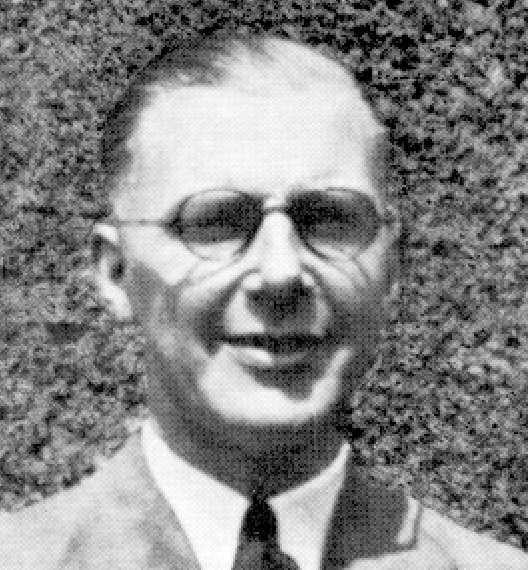 Rev. F. C. Minard PerkinsMr Perkins married late in 1936, but sadly his wife, Doreen, after a long illness, died of pneumonia in November 1939. Mr Perkins' aunt, Miss Frances Minard, came to keep home for him.
Rev. F. C. Minard PerkinsMr Perkins married late in 1936, but sadly his wife, Doreen, after a long illness, died of pneumonia in November 1939. Mr Perkins' aunt, Miss Frances Minard, came to keep home for him.
May 5, 1935, saw the commencement of the ministry of Rev F. C. Minard Perkins from Marlow (his first pastorate). He was a single man and soon settled down to work at Greenford. The church, despite a few teething problems, continued to grow.
The War Years
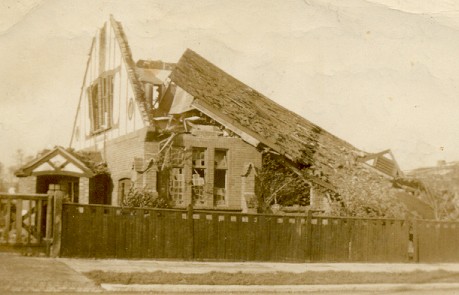 The Bombed ChurchWar clouds had begun to form and darken the skies, and in September 1939, the war finally broke out. News of it was first heard at morning service, and the air raid sirens sounded almost immediately. It was, however, unanimously agreed to continue with the service despite the warning, which, in fact, proved to be a false alarm. On Monday, September 30 1940, the warning sirens were not wrong. At 12.40 a.m., the church, for which so much hard work had been given, was destroyed by a direct hit of a high explosive heavy calibre bomb.
The Bombed ChurchWar clouds had begun to form and darken the skies, and in September 1939, the war finally broke out. News of it was first heard at morning service, and the air raid sirens sounded almost immediately. It was, however, unanimously agreed to continue with the service despite the warning, which, in fact, proved to be a false alarm. On Monday, September 30 1940, the warning sirens were not wrong. At 12.40 a.m., the church, for which so much hard work had been given, was destroyed by a direct hit of a high explosive heavy calibre bomb.
Many homes in the area were also struck, doing much damage to property, insignificant, however, compared with the tragic loss of life and injury. Several church members also lost their homes.
Offers of Help
Both the Greenford Methodists and friends from the Church of England (Holy Cross) offered all possible assistance and use of premises. At first, Church services continued at the Methodist Church, but after a while, members met at Stanhope Boys School. On the ruined building was a notice, "The Church is down, but we are not." Midweek prayer meetings were held at the Manse.
The Tin Tabernacle
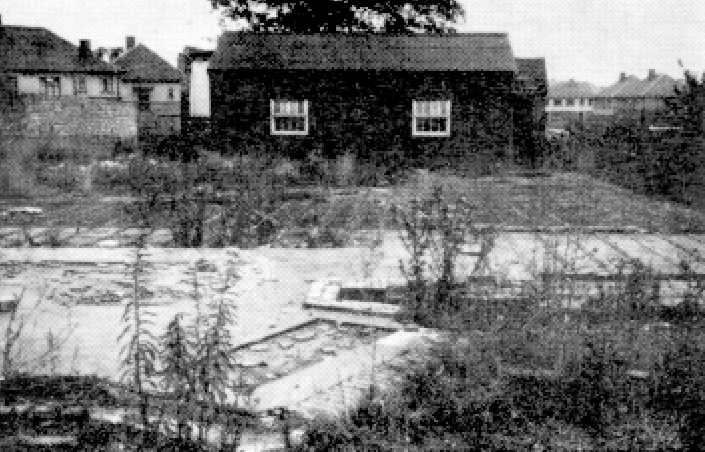 The Tin TabernacleThe first donation for a new church came from friends at Haven Green in December 1940. This was followed by a gift from Marlow Baptist Church (Rev Perkins' previous church). Members of the Greenford Church soon became restless for a new building, and a temporary building fund was started. By the end of June 1941, the fund had reached £133.
The Tin TabernacleThe first donation for a new church came from friends at Haven Green in December 1940. This was followed by a gift from Marlow Baptist Church (Rev Perkins' previous church). Members of the Greenford Church soon became restless for a new building, and a temporary building fund was started. By the end of June 1941, the fund had reached £133.
A local farmer, a Baptist Lay Preacher, had an old corrugated iron outbuilding which he offered for the sum of £10. With the assistance of a local builders merchant, H. G. Slade, the craftsman husband of one of the members, and Mr W. A. Whipps, the dismantling and re-erecting of the building on the church site was made along with all that remained of the original building, the kitchen and toilets. The 'Tin Tabernacle' sufficed for a while (apart from leakage when it rained) and seated 100 people. Friends at Western Road Baptist Church, Southall, helped by offering their baptistry when needed.
At this time, the Sunday School and other Youth work had ceased as most children of the district had been evacuated chiefly to South Wales, Gower Peninsula and Devon.
As mothers and children started to filter back, Sunday School began again, and at first, classes were held in homes. By October 1941, there were sufficient children to enable normal Sunday School to recommence. Mr Moore, a local chemist, who had a shop opposite Eastmead Avenue along Ruislip Road, offered to use his premises. This helped considerably, and part of the Sunday School was held there. It was looked upon as the Youth Centre as it was also used by Mrs and Miss Jackson, who ran Campaigners, and the Girls Life Brigade (as it was called then) also used it. Mrs and Miss Burt also found a home in the flat above and Lena Burt still lives there today.
Oldfield Baptist Church
At Bloomsbury Central Church on September 23 1942, Rev Perkins married again. His second wife, Rose Parnell from Portsmouth, had been working for the National Children's Home.
In 1944 the Greenford Church was asked to oversee Oldfield Baptist Church. One of the deacons, Mr P. Turner, and his family were transferred to membership there and did a fine job for several years before emigrating to Australia with his daughter and son-in-law. Mr Perkins gave part of his time to Oldfield Baptist, for which they made a contribution toward his stipend.
In April 1946, Mr L. B. Crowe came to the church at Greenford from London Bible College as an assistant to Mr Perkins to help with the work at Oldfield Baptist Church. In October 1946, he became their full-time Pastor.
The Extension
By the Spring of 1944, accommodation at the 'Tin Tabernacle' became insufficient. It was obvious that new plans would have to be made. It was decided to extend the temporary building by knocking out one end and adding a brick-built section. The work was given to a local builder who completed the task for £144. This increased the seating capacity to 150, but it was only adequate for a short time.
Mr Perkins, due to illness, had been advised by his doctor to move south, and for the first time in its history, the church was to be without a Pastor. At that time, the pastorate at Romsey Baptist Church became vacant. In response to an invitation from the church, Mr Perkins left, albeit regretfully, in late September 1946.
Rev N. R. Richards
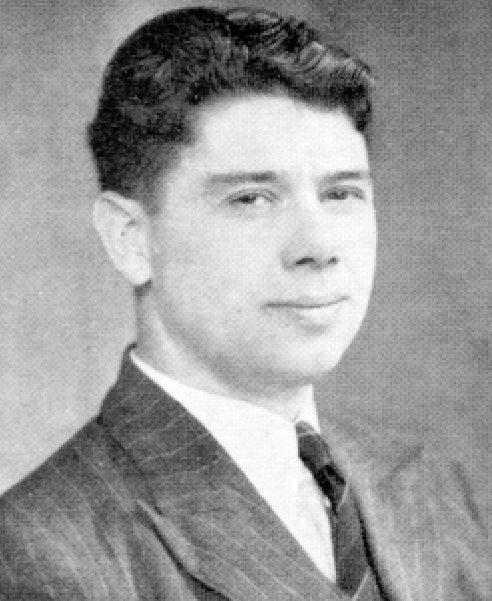 Rev N. R. RichardsDuring the interregnum, Rev Hugh Butt from Southall and Rev G. Picketing of Hanwell were moderators for the church. The time without a minister lasted until September 1947, when on the 20th, Rev N. R. Richards from South Wales Baptist College, Cardiff, was ordained and inducted to the pastorate.
Rev N. R. RichardsDuring the interregnum, Rev Hugh Butt from Southall and Rev G. Picketing of Hanwell were moderators for the church. The time without a minister lasted until September 1947, when on the 20th, Rev N. R. Richards from South Wales Baptist College, Cardiff, was ordained and inducted to the pastorate.
Rev Richards' ministry proved successful, and it was not long before lack of space became a problem again.
The Pre-Fab
 The Pre-fabBuilding restrictions were still very severe, and after much searching, a sectional prefabricated concrete structure was found. This building was commonly used during the war for public restaurants, where a substantial coupon-free meal could be obtained at a moderate price!
The Pre-fabBuilding restrictions were still very severe, and after much searching, a sectional prefabricated concrete structure was found. This building was commonly used during the war for public restaurants, where a substantial coupon-free meal could be obtained at a moderate price!
This was purchased for £185, and a temporary building licence was secured for three years. One of the deacons, the late Mr F. Hall, a builder who had worked with the local Council, agreed to supervise the building.
The structure was in pre-cast concrete sections with concrete supports for the wooden girders. The men and older boys of the church, together with the Pastor, worked every Saturday and the longer evenings during the week.
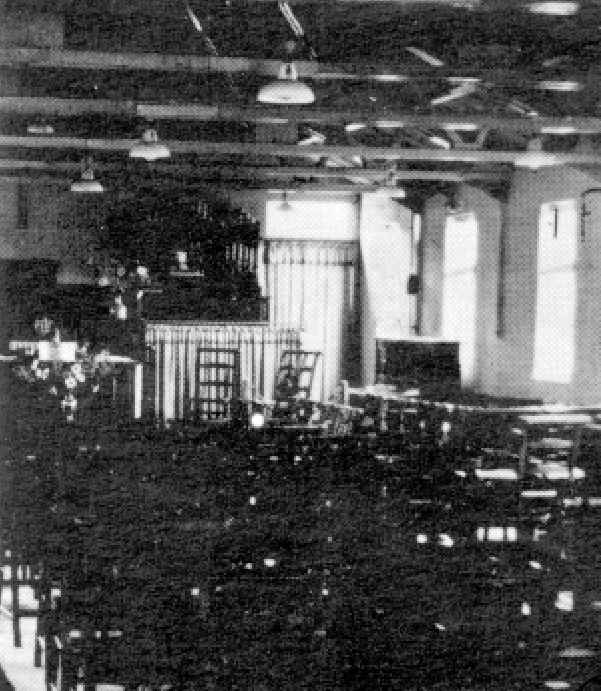 Inside the Pre-fabElectrical equipment providing heating for the winter and fans for the summer were installed. A baptistry was also built, the only problem being how to fill and empty it. This was finally overcome by running a hose from the old kitchen to fill it, and using the same hose with a suction pump, it could be emptied.
Inside the Pre-fabElectrical equipment providing heating for the winter and fans for the summer were installed. A baptistry was also built, the only problem being how to fill and empty it. This was finally overcome by running a hose from the old kitchen to fill it, and using the same hose with a suction pump, it could be emptied.
The new building was opened on April 16, 1949, by the Mayoress of Ealing.
In 1953 notice was given to dismantling the temporary structure to make way for the front part of the present building, under War Damage Commission claim. The problem was how to dispose of it.
As an answer to prayer, The 'Pre-Fab was received from the Reading branch of the British Legion to purchase it. This was agreed upon, provided they made the arrangements for dismantling and removing it. They agreed and for £137 purchased it. Building work had now to begin all over again.
Foundation Problems
During this time, Methodist friends gave assistance again during this time, and Sunday Services were held in their hut.
The bomb, which had destroyed the original church, demolished the building and went through solid concrete foundations to leave a crater some 25-30 feet wide. There was some delay due to a dispute with the War Damage Commission regarding the crater, and no firm bottom could be found in the crater. Consequently, before they allowed rebuilding to proceed further, they insisted that the hole be filled with dry cement and the foundations strengthened by driving piles all around the foundations. This work added considerably to the bill, but the War Damage Commission finally agreed to pay it.
The architect said afterwards that it was the strongest foundation he knew within miles! The church was on a sure foundation in more ways than one. The deep piles, however, were, 14 years later, to be the source of more headaches when the existing extension was built. They apparently did not appear on the plans lodged with the Town Hall, so the architect was unaware of their presence.
On Saturday, April 23 1955, the present church building was opened for worship. The total cost amounted to approximately £30,000.
Retirement of Rev Richards
In July 1955, Rev Richards became very ill and needed an extended stay in the hospital. It was not until September 4, 1956, that he was well enough to attend a Deacons' Meeting. At the meeting, he informed them of his wish to resign from the pastorate, having been given strong medical advice. This he did on October 10 1956.
Through the long and trying period of interregnum, the deacons and members faithfully maintained the witness of the church, greatly assisted by the Area Superintendent, Rev W. D. Jackson.
Rev E. M. Forward
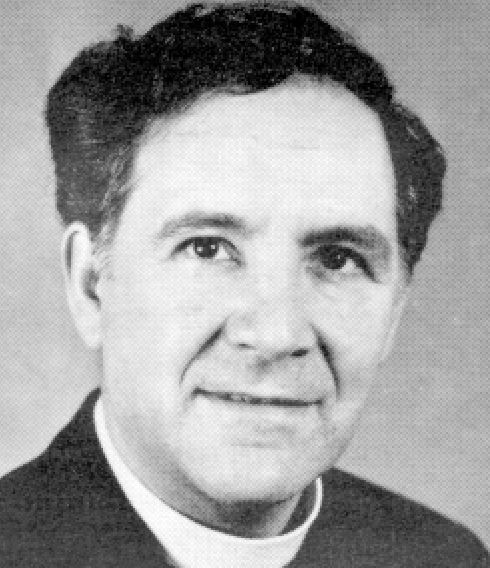 Rev. E. M. ForwardFor two years, the church was without a Pastor, and Rev A. E. Willmot agreed to be the moderator, a position which he filled with distinction until Rev E. M. Forward from Bushey Baptist Church was inducted to the Pastorate on Saturday, October 18 1958
Rev. E. M. ForwardFor two years, the church was without a Pastor, and Rev A. E. Willmot agreed to be the moderator, a position which he filled with distinction until Rev E. M. Forward from Bushey Baptist Church was inducted to the Pastorate on Saturday, October 18 1958
Mr and Mrs Forward settled down quickly. Rev Forward's ministry was essentially evangelical (bible believing) and proved particularly fruitful among the young people. Three of them have since become Baptist ministers– Dr Paul Fiddes, Rev James Binney and Rev Stephen Barton.
The main hall (Browning Hall) was too large for small gatherings, whilst the two dressing rooms adjacent to what used to be the stage at that time were too small and frequently unusable anyway, as equipment was stored in them.
On January 5 1959, the question of an extension was raised at the Deacons' Meeting. The first application for a loan from the Baptist Building Fund and the London Baptist Property Board was made in March 1959. The Northolt Village Mission greatly encouraged the church by making a generous donation of £1,000. Unfortunately, the Baptist Building Fund could not grant a loan at that time and suggested application be made again in 1960.
The architect, Mr A. O. Edwards, submitted a proposal which amounted to £9,000, which was generally agreed upon. From the old minutes of the meeting held on September 20 1961, it was stated that "it was hoped to start building in 1963". The first attempt was not, however, proceeded. It was not until 1964 that the question was raised again, and this time Mr Cyril Greening of K. C. White and Partners was appointed architect.
The extension started in 1969 and the new halls were opened for use on May 30, 1970, at the cost of £22,000.
Rev Forward did not remain to see the building started as he left Greenford in December 1967 to take up the pastorate at New Malden Baptist Church. Once again, Rev A. E. Willmott stepped in as moderator during the interregnum, which lasted nearly 2 years. During this time, Mr D. Urquhart, the Church Secretary, shouldered much responsibility. Mr Urquhart and his wife have been active church members since 1953. (In 1978, Mr Urquhart retired as Church Secretary after 25 years of faithful service).
After a long period without a minister, Rev L. A. Bayly from Mansfield was called to the pastorate and commenced his ministry on November 1 1969. Earlier in his ministerial life, Rev Bayly had been associated with West Ealing Baptist Church. Through hard work and determination, the church finally became free from the burden of the building extension debt during Rev Bayly's ministry at Greenford. Rev Bayly sacrificed much personally so that the church debts might be paid. With his constancy and faithful teaching ministry, proved to be a great blessing and inspiration to many people.
Rev L. A. Bayly
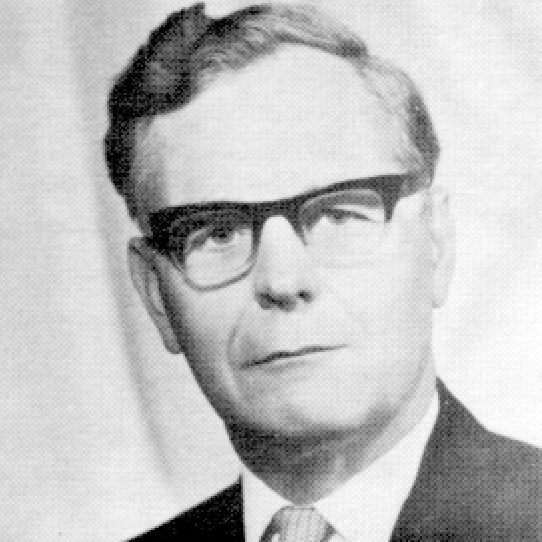 Rev. L. A. BaylyAfter a trying time with his health, Rev Bayly felt that he should retire from the ministry and in March 1977, he and his wife moved to Ramsgate.
Rev. L. A. BaylyAfter a trying time with his health, Rev Bayly felt that he should retire from the ministry and in March 1977, he and his wife moved to Ramsgate.
Rev M. Goodspeed from North Hanwell Baptist Church agreed to be the moderator. During this time, he helped and encouraged the church considerably.
Rev John Bunt
 Rev. John BuntOnce again, the church had to find a new man. On September 17 1977, Rev John Bunt from Bristol was inducted into the Pastor at Greenford.
Rev. John BuntOnce again, the church had to find a new man. On September 17 1977, Rev John Bunt from Bristol was inducted into the Pastor at Greenford.
Through the history of the Baptist Church at Greenford, with its changes in building and ministers, it cannot be forgotten that God has been with His people, inspiring, encouraging, guiding and comforting. It is to Him that the church as a body of Christians must look for the future.
Greenford in 1980 The Church that is not experiencing change is probably not growing and not enjoying the fullness of the Lord's blessing since the Lord is always leading us on into new things. A Church that is alive must, by definition, be growing.
The coming of the Reverend John Bunt to the Church at Greenford in September 1977 was the culmination of a brief but valuable interregnum in which the Lord was already bringing about change in practical ways and spiritual direction.
The initial impact of Mr Bunt's arrival was notably chiefly due to Andrew and Nicola Bunt (then aged 4 and 2 for those unacquainted). Since there was a lack of young families in the church then, introducing two high-spirited youngsters was quite a shock.. However, their father tells me that now the initial excitement of new surroundings has worn off, they are really relatively placid children!
The lack of young families in the church was one of the initial problems tackled with a change from afternoon to morning Sunday School and the introduction of monthly family services. Although not without its problems, primarily for the Sunday School in making the necessary adjustments, this change has transformed the morning service from a small gathering to a normal full Church. An added joy on a number of occasions has been the moving back of the partitioning to accommodate the overflow into the Browning Hall.
Another feature of the morning service is the number of dedication services held, which are becoming something of a speciality to our Pastor, and a source of 'internal Church growth'.
A great joy, in the early months of Mr Bunt's ministry, was to reap where others had sown and seven girls were received into membership following baptism.
In the last two years missionary interest has been stimulated by the departure to Zaire of Miss Joan Maple; the first BMS missionary from this church. Joan's valedictory service was on February 13 1978 and in August of that year, Joan came home for a holiday and was able to give us all a personal insight into the work.
Links with a number of Baptist Churches have been strengthened through the return of 'old boys' Rev Stephen Barton (Stanmore) and Rev Jim Binney (Streatham) to the London area and the closer ties forged with North Hanwell in the interregnum. From all these sources Church life at Greenford has certainly benefited and we are thankful for these friends and others who support the work at Greenford.
In a short article, one cannot possibly do justice to the tremendous week-by-week work that is done in so many Church organisations including the Boys and Girls Brigades, Sunday School, Christian Endeavour, Youth Club, Women's Own and Ladies Fellowship. Much of the life of the church is expressed in their activities and we pray the Lord will continue to bless each organisation as parts of one church growing both numerically and spiritually.
On the practical front Mr Bunt inherited a Church free of the debt incurred in the construction of the new building. However as a partial consequence, much has needed to be spent on the Manse and Church building, although the dramatic increase in offerings has been something for which we have truly given the Lord our thanks.
Although the church has only been involved in limited evangelistic efforts in the neighbourhood, for example, the 'PACE' witness in local schools, it has been encouraging to see the Lord bringing people to the church and we pray that the fellowship at Greenford may become so warm and attractive that many others may be drawn to us in this way.
Perhaps the keynote of Mr Bunt's ministry over the past two years has been to promote the need for the whole Church family, young and old, to have a reality of the day-to-day experience of the Lord's fullness, promoting the fruit of the Spirit and in particular that real joy of the Lord in our hearts.
In pressing toward this goal much of the work has been in tackling attitudes within the church and a foundation has now been laid from which greater things may be achieved. There is certainly no room for complacency in any Church and often the achievements of the past, whilst great, seem small in relation to the future challenge.
David Ledster (Church Secretary, 1980)
Looking Forward
Written by past Minister Rev John Bunt in 1980
As minister of Greenford Baptist church, I would like to acknowledge the tremendous debt the church owes to its past members and ministers. Their faith and inspiration empowered them to continue, particularly after the destruction of the church building during the war. It is my intention, in this article, to share a vision of what Greenford Baptist Church exists for, both now and for the future.
Opportunity To Worship
The first, and most important, reason that Greenford Baptist Church exists is to provide an opportunity for people to worship God within the framework of a Free Church. What does worship mean? I believe it means–adoration, thanksgiving, confession, petition, meditation and dedication–all that prayer is in fact.
Those who exclude God from their lives often find they are left with a sense of hopelessness and despair. This forlorn attitude is expressed in two statements which I read recently about man. The first was "Man is a low form of cellular life on his way to the manure heap". The second, "Man is fighting a lone battle against a vast indifference". Such is the spirit of hopelessness when people exclude God from their thinking. Greenford Baptist Church stands as a beacon–a light in the middle of darkness. It offers people an opportunity to believe in and to worship someone strong, loving, serene and holy.
Opportunity To Offer Christ
The second reason that Greenford Baptist Church exists is to offer Jesus Christ to men, women, boys and girls.. I recall the story of a journalist, a lonely man, who was in despair of his life to the extent of wanting to kill himself with poison. On the way to find a place to commit his suicide, he passed a church. An impulse led him inside.
As a result of the ministry which he received inside, he came out, threw away the poison, sought the minister and subsequently began a new life. He had met with people in that church who offered him Jesus Christ as an answer to his problems. Without that witness, the man would have died in his despair.
All around are people who are like this journalist, They are unhappy, burdened with problems, repressed, inhibited and bewildered. They are unable to see beauty, meaning or joy in life. The church has something to offer that can end their loneliness, lighten their burdens and transform their lives. It is a living Saviour–Jesus Christ the Lord.
Opportunity For Fellowship
The third reason Greenford Baptist Church exists is to offer an opportunity for fellowship among all ages. One of the things that please me is to hear someone say, "As soon as I came into the church, I felt I was among friends". I want that to be true of Greenford Baptist Church. Love is the key here. It is so easy to find fault–to see where others are wrong rather than be eager to see and draw out the best in people. Love and prayers in the fellowship will make it easier for others to find God. I am quite sure that the synagogue was quite a different place when Jesus was present. If we come in the right spirit and ask God to unite the church and to give it a true sense of fellowship, the whole service will be a blessing to all who come to it.
The church is the fellowship of God's people, however old or young. The child dedication service indicates that parents are anxious for the church to be included in the bringing up of their child into the family of God. Part of this may mean the church helping in practical ways too. Often the very loveliest of God's gifts–a child–can cause parents to drift away from the fellowship because of the practical problems in bringing up children. Parents and children coming to church together will build up a strong sense of family worship. This is something which needs to be encouraged in the fellowship. Sunday school is also a good opportunity for children to take a more definite part in church life from their earliest years.
What a wonderful thing it is for Greenford Baptist Church to serve the community by offering joy and meaningfulness of life with Christ at the centre. Without Him, there is no purpose. The world offers many fleeting pleasures, many of which lead to emptiness and despair. The church can offer God, Christ, new life, true fellowship, good humour, service to the community, and through it all, worship of Him who loved us and gave Himself for us.
I believe we are stepping out into a tremendously hopeful future with many possibilities. I call upon God's people to help by continuing in prayer, dedication, love and faith, which will strengthen and build up the Greenford Baptist Church of tomorrow.
Research and the original draft of the history of Greenford Baptist Church was kindly co-ordinated by the late Mr A.J. Bosworth, one of the original founders and, latterly, Church Treasurer. Also acknowledged with grateful thanks is the gift from his wife May, in memory of her husband toward publishing this Jubilee Magazine. Produced and edited by Jean Anness in 1980. Historical photographs by courtesy of Mr W.A. Whipps.